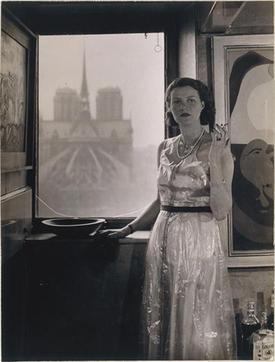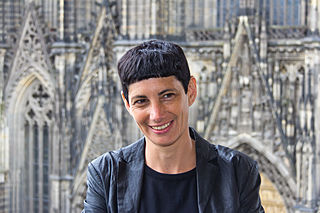Related Research Articles

Marguerite "Peggy" Guggenheim was an American art collector, bohemian, and socialite. Born to the wealthy New York City Guggenheim family, she was the daughter of Benjamin Guggenheim, who went down with the Titanic in 1912, and the niece of Solomon R. Guggenheim, who established the Solomon R. Guggenheim Foundation. Guggenheim collected art in Europe and America between 1938 and 1946. She exhibited this collection as she built it. In 1949, she settled in Venice, where she lived and exhibited her collection for the rest of her life. The Peggy Guggenheim Collection is a modern art museum on the Grand Canal in Venice, Italy, and is one of the most visited attractions in Venice.
Imants Tillers, is an Australian artist, curator and writer. He lives and works in Cooma, New South Wales.

Emily Jacir is a Palestinian artist and filmmaker.

Yael Bartana is an Israeli artist, filmmaker and photographer, whose past works have encompassed multiple mediums, including photography, film, video, sound, and installation. Many of her pieces feature political or feminist themes.
Fiona Tan is a visual artist primarily known for her photography, film and video art installations. With her own complex cultural background, Tan's work is known for its skillful craftsmanship and emotional intensity, which often explores the themes of identity, memory, and history. Tan currently lives and works in Amsterdam, the Netherlands.

Roslyn Oxley9 Gallery is an art gallery in Sydney, owned and operated by Roslyn Oxley and her husband Tony Oxley. The gallery has been a longstanding contributor to regional, national and international art fairs, and supporter of a range of mono-disciplinary and interdisciplinary contemporary artists. Artists represented by Roslyn Oxley9 Gallery include Isaac Julien, Yayoi Kusama and representatives for Australia and New Zealand at the Venice Biennale.

Stephen Antonakos was a Greek born American sculptor most well known for his abstract sculptures often incorporating neon.

Catherine de Zegher is a Belgian curator and a modern and contemporary art historian. She has a degree in art history and archaeology from the University of Ghent.

Simone Leigh is an American artist from Chicago who works in New York City in the United States. She works in various media including sculpture, installations, video, performance, and social practice. Leigh has described her work as auto-ethnographic, and her interests include African art and vernacular objects, performance, and feminism. Her work is concerned with the marginalization of women of color and reframes their experience as central to society. Leigh has often said that her work is focused on “Black female subjectivity,” with an interest in complex interplays between various strands of history. She was named one of the 100 most influential people in the world by Time magazine in 2023.
The Guggenheim UBS MAP Global Art Initiative was a five-year program, supported by Swiss bank UBS in which the Solomon R. Guggenheim Foundation identified and works with artists, curators and educators from South and Southeast Asia, Latin America, and the Middle East and North Africa to expand its reach in the international art world. For each of the three phases of the project, the museum invited one curator from the chosen region to the Solomon R Guggenheim Museum in New York City for a two-year curatorial residency, where they worked with a team of Guggenheim staff to identify new artworks that reflect the range of talents in their parts of the world. The resident curators organized international touring exhibitions that highlight these artworks and help organize educational activities. The Foundation acquired these artworks for its permanent collection and included them as the focus of exhibitions that open at the museum in New York and subsequently traveled to two other cultural institutions or other venues around the world. The Foundation supplemented the exhibitions with a series of public and online programs, and supported cross-cultural exchange and collaboration between staff members of the institutions hosting the exhibitions. UBS reportedly contributied more than $40 million to the project to pay for its activities and the art acquisitions. Foundation director Richard Armstrong commented: "We are hoping to challenge our Western-centric view of art history."
Koo Jeong A is a South-Korean born mixed-media and installation artist.
June Yap is a Singaporean curator, art critic, and writer. She is currently the Director of Curatorial & Collections at the Singapore Art Museum.

Kimsooja was born in Daegu, South Korea. Kimsooja is a multi-disciplinary conceptual artist who travels between her three homes and places of work in New York City, Paris, and Seoul. In 1980 Kim graduated with a B.F.A in Painting from Hong-Ik University, Seoul and continued to pursue her M.F.A there, obtaining the degree in 1984 at the age of 27. Her origin as a painter was a crucial starting point for the development of her art. That same year, she received a scholarship to study art at Ecole Nationale Supérieure des Beaux-Arts in Paris, France, where she studied Printmaking. Her first solo exhibition was held in 1988 at Gallery Hyundai, Seoul. Currently, her work is featured in countless international museums and galleries as well as public art fairs and other spaces. Her practice combines performance, film, photo, and site-specific installation using textile, light, and sound. Kimsooja's work investigates questions concerning the conditions of humanity, while engaging issues of aesthetics, culture, politics, and the environment. Her principle of ‘non-doing’ and ‘non-making,’ which follows a conceptual and structural investigation of performance through modes of mobility and immobility, inverts the notion of the artist as the predominant actor.
Agnieszka Kurant is a Polish interdisciplinary conceptual artist. She examines how economic, social, and cultural systems work in ways that blur the lines between reality and fiction.

NTU Centre for Contemporary Art Singapore is a national research centre affiliated with Nanyang Technological University (NTU).
Natalie King is an Australian curator and writer working in Melbourne, Australia. She specializes in Australian and international programs for contemporary art and visual culture. This includes exhibitions, publications, workshops, lectures and cultural partnerships across contemporary art and indigenous culture.
The American pavilion is a national pavilion of the Venice Biennale. It houses the United States' official representation during the Biennale.
Susan Norrie is an Australian artist working primarily with found film and original video installations to explore political and environmental issues. In 2007 she represented Australia at the 52nd Venice Biennale.
Wah Nu is a contemporary artist from Myanmar.

Suzann Victor is a Singaporean contemporary artist based in Australia whose practice spans installation, painting, and performance art. Victor is most known for her public artworks and installations that examine ideas of disembodiment, the postcolonial, and the environmental in response to space, context and architecture.
References
- ↑ "Simryn Gill - Biography | Richard Saltoun". www.richardsaltoun.com. Retrieved 2024-04-30.
- ↑ "Stolon Press" . Retrieved 2021-06-20.
- 1 2 3 4 5 Yusof, Helmi (March 27, 2015). "In Search of a Lost Time". The Business Times. Retrieved April 17, 2021.
- 1 2 "Simryn Gill". The Solomon R Guggenheim Foundation.
- 1 2 Fitzgerald, Michael (May 25, 2013). "Raising the Roof". The Sydney Morning Herald. Retrieved April 17, 2021.
- 1 2 3 4 Fitzgerald, Michael (April 2013). "Against Blankness – The Inhabiting Spaces of Simryn Gill". ArtAsiaPacific. No. 82. Retrieved July 11, 2016.
- 1 2 Forrest, Nicholas (May 31, 2013). "See Simryn Gill's Venice Biennale Australia Pavilion". Australia: BlouinArtinfo. Retrieved July 11, 2016.
- ↑ Hauser, Kitty (May 25, 2013). "Artists Simryn Gill becomes Australia's accidental ambassador at Venice Biennale". The Australian.
- 1 2 Storer, Russell; Morgan, Jessica; Taussig, Michael (2008). Simryn Gill. Koln. pp. 7, 41.
- 1 2 "Simryn Gill – My Own Private Angkor, #51, 2007–2009". Artsy. Retrieved July 11, 2016.
- ↑ Gill, Simryn (2008). Pearls. Raking Leaves.
- 1 2 Chua, Kevin (2002). "Simryn Gill and Migration's Capital". Art Journal. 61 (4): 4–21. doi:10.2307/778147. JSTOR 778147 – via Academic Search Premier.
- ↑ Vali, Mutaza (2021). "Perspectives". ArtAsiaPacific. Retrieved April 20, 2021.
- ↑ Ho, Louis. "Review, 'Hugging the Shore' (Simryn Gill)". ArtAsiaPacific. 94.
- 1 2 3 4 Fitzgerald, Michael (May 25, 2013). "Raising the Roof". The Sydney Morning Herald. Retrieved April 20, 2021.
- ↑ Gill, Simryn (2013). Here art grows on trees. Australia Council for the Arts. p. 29.
- ↑ Yap, June. "Simryn Gill – Full Moon". The Solomon R Guggenheim Foundation. Retrieved July 28, 2016.
- ↑ "Simryn Gill". The Museum of Modern Art. Retrieved July 28, 2016.
- ↑ "Simryn Gill". San Francisco Museum of Modern Art. Retrieved July 28, 2016.
- ↑ "A Small Town at the Turn of the Century 1999–2000". Tate. Retrieved July 28, 2016.
- ↑ "Works by Simryn Gill". Art Gallery of New South Wales. Retrieved July 28, 2016.
- 1 2 "Simryn Gill". Artsy. Retrieved July 6, 2016.
- 1 2 "Simryn Gill to represent Australia at the Venice Biennale 2013" (Press release). Australia Council for the Arts. May 23, 2012. Retrieved July 6, 2016.
- ↑ "Simryn Gill – Press Kit". Tracy Williams, Ltd. Retrieved July 6, 2016.
- ↑ "Simryn Gill: Hugging the Shore". NTU Centre for Contemporary Art Singapore. Nanyang Technological University. Retrieved July 28, 2016.
- ↑ "Simryn Gill". Museum of Contemporary Art Australia. Retrieved July 13, 2016.
- ↑ "Simryn Gill". dOCUMENTA (13). Retrieved July 28, 2016.
- ↑ "Simryn Gill". Universes in Universe. Retrieved July 28, 2016.